Introduction of Self Cleaning Vacuum History
In recent years, self cleaning vacuums have revolutionized household cleaning, bringing a new level of convenience and efficiency. These devices have come a long way since their inception, offering increasingly sophisticated features that not only simplify cleaning tasks but also improve the overall hygiene and air quality in homes.
The Early Days of Self Cleaning Vacuum
Self cleaning vacuums first appeared in the 1990s, driven by the need for a more efficient and hygienic cleaning solution. Early models featured basic brush roll systems aimed at dislodging debris from the vacuum’s components. However, these prototypes were often plagued by inconsistent performance and limited durability, highlighting the need for further innovation.
A New Era of Self Cleaning Vacuum
The 21st century brought significant technological advancements in self-cleaning vacuums. The introduction of the cyclonic self cleaning system marked a major milestone. This system employs centrifugal force to separate dirt and debris from the airflow, which helps in reducing the need for manual cleaning and increases the overall efficiency of the vacuum.
Enhanced Filtration: HEPA Filters Take Center Stage
One of the most significant advancements in self-cleaning vacuums is the incorporation of High Efficiency Particulate Air (HEPA) filters. These filters can trap 99.97% of particles as small as 0.3 microns, including dust, pollen, and other allergens. This feature not only enhances the vacuum’s ability to clean but also significantly improves indoor air quality, making it a popular choice for those with allergies.
Going Autonomous: The Rise of Robotic Vacuums
The introduction of robotic self cleaning vacuums represents another significant leap forward. These autonomous devices are equipped with advanced sensors and artificial intelligence, enabling them to navigate obstacles, map out rooms, and return to their charging dock when the battery is low. Some models even include self-emptying capabilities, further reducing the need for user intervention.
The Impact on Modern Households
Self-cleaning vacuums have had a profound impact on modern households by automating the cleaning process, saving time and effort. These devices not only make daily chores easier but also contribute to a healthier living environment by enhancing hygiene and air quality.
Weighing the Pros and Cons
While self cleaning vacuums offer numerous advantages, they are not without their challenges. The initial cost can be high, and some models require regular maintenance to perform optimally. Additionally, while effective at removing debris, these vacuums may not be as efficient at tackling stubborn stains or deep-seated dirt.
Conclusion of Self Cleaning Vacuum
The evolution of self cleaning vacuums reflects a significant advancement in domestic appliances. From their rudimentary beginnings to the sophisticated robotic models available today, these devices have redefined how we approach cleaning and maintenance. As technology continues to evolve, self cleaning vacuums are likely to become even more efficient and user-friendly, offering unparalleled convenience for modern households. Whether you’re aiming to save time, improve your home’s air quality, or simply make cleaning easier, a self cleaning vacuum is an investment worth considering.
FAQ: The Evolution of self cleaning Vacuums
Q1: What are self cleaning vacuums?
- A1:self-cleaning vacuums are advanced cleaning devices designed to automate the process of removing dirt and debris from their internal components, reducing the need for manual maintenance.
Q2: When did self cleaning vacuums first emerge?
- A2:self-cleaning vacuums first appeared in the 1990s, with early models featuring basic brush roll systems to help dislodge debris.
Q3: How have self cleaning vacuums evolved over time?
- A3:Over time, self-cleaning vacuums have evolved with significant technological advancements, including the introduction of cyclonic self cleaning systems, HEPA filters, and robotic models with AI capabilities.
Q4: What is the cyclonic self cleaning system?
- A4:The cyclonic self cleaning system uses centrifugal force to separate dirt and debris from the vacuum’s airflow, reducing the need for manual cleaning and improving efficiency.
Q5: What role do HEPA filters play in self cleaning vacuums?
- A5:HEPA filters in self cleaning vacuums trap 99.97% of airborne particles as small as 0.3 microns, enhancing cleaning efficiency and improving indoor air quality.
Q6: What are robotic self cleaning vacuums?
- A6:Robotic self cleaning vacuums are autonomous devices equipped with sensors and AI, allowing them to navigate rooms, avoid obstacles, and return to their charging docks. Some models also feature self-emptying capabilities.
Q7: How have self-cleaning vacuums impacted modern households?
- A7:self-cleaning vacuums have automated the cleaning process, saving time and effort while improving household hygiene and air quality.
Q8: What are the benefits of self-cleaning vacuums?
- A8:Benefits include time-saving automation, improved cleaning efficiency, and enhanced air quality, particularly with the use of HEPA filters.
Q9: Are there any drawbacks to self-cleaning vacuums?
- A9:Drawbacks include the high initial cost, the need for regular maintenance, and potential inefficiency in handling stubborn stains or deep-seated dirt.
Q10: What does the future hold for self-cleaning vacuums?
- A10:As technology continues to advance, self-cleaning vacuums are expected to become even more efficient and user-friendly, offering greater convenience for modern households.

